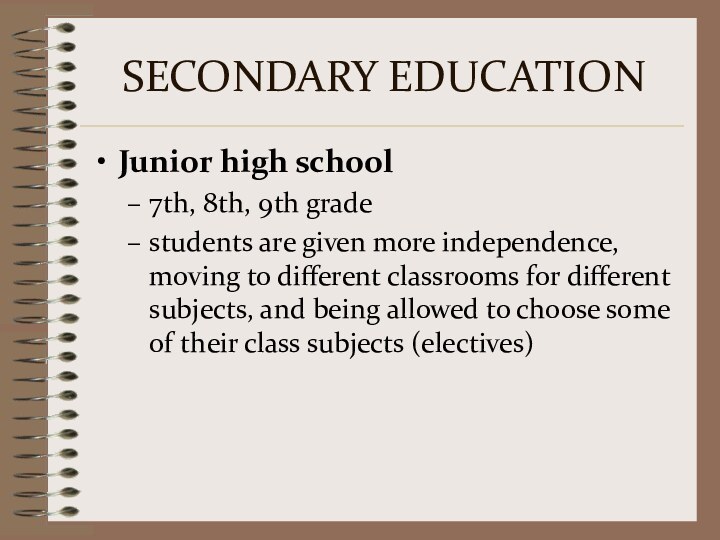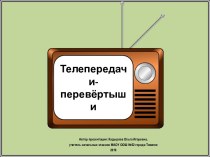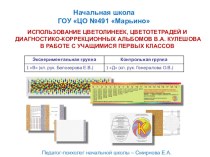Слайд 2
Public / private / home schooling
Public education funded
by the local → state → federal government (85%
of all students)
The policies (curricula, funding, teaching methods) are set through locally elected school boards with jurisdiction over school districts
The ages for compulsory education vary by state – from 5-8 to 14-18
Слайд 4
ELEMENTARY EDUCATION
Admission - based on residency
the curriculum in
public elementary education is determined by individual school districts
(14,000 school districts in the country).
In general, a student learns basic arithmetic and sometimes rudimentary algebra in mathematics, English proficiency (such as basic grammar, spelling, and vocabulary), and fundamentals of other subjects (social studies, sciences)
Слайд 5
ELEMENTARY EDUCATION
The No Child Left Behind Act of
2001 (NCLB) is a United States Act of Congress
– a form of the government's aid program for disadvantaged students. NCLB supports standards-based education reform based on the premise that setting high standards and establishing measurable goals can improve individual outcomes in education. The Act requires states to develop assessments in basic skills.
The Act does not assert a national achievement standard; standards are set by each individual state. NCLB expanded the federal role in public education through annual testing, annual academic progress, report cards, teacher qualifications, and funding changes.
Слайд 7
SECONDARY EDUCATION
Junior high school
7th, 8th, 9th grade
students are given more independence, moving to different classrooms
for different subjects, and being allowed to choose some of their class subjects (electives)
Слайд 8
SECONDARY EDUCATION
Senior high school
(9th) 10th through 12th
grade.
The students in these grades are commonly referred
to as freshmen (grade 9), sophomores (grade 10), juniors (grade 11) and seniors (grade 12).
Слайд 9
SECONDARY EDUCATION
Curriculum:
mandatory subjects (studied for 2, 3 or
4 years):
Science (biology, chemistry and physics)
Mathematics (algebra, geometry, pre-calculus,
statistics)
English (literature, humanities, composition, oral languages, etc.)
Social sciences (history, government/economics courses)
Physical education
Слайд 10
SECONDARY EDUCATION
Curriculum:
Electives
Computers (word processing, programming, graphic design)
Athletics (cross
country, football, baseball, basketball,softball, wrestling, cheerleading, volleyball, lacrosse, ice
hockey, field hockey, marching band, etc.)
Career and Technical Education (Agriculture/Agriscience, Business/Marketing, Family and Consumer Science, Health Occupations, and Technology Education, including Publishing)
Performing Arts/Visual Arts, (choir, band, orchestra, drama, art, ceramics, photography, and dance)
Foreign languages (usually Spanish or French)
Junior Reserve Officers' Training Corps
Слайд 11
SECONDARY EDUCATION
Grading
The scale
Слайд 12
SECONDARY EDUCATION
Grading
Report cards
Слайд 13
SECONDARY EDUCATION
Testing
yearly state tests to measure the "adequate
yearly progress." (NCLB Act)
SAT Reasoning Test - (formerly Scholastic
Aptitude Test and Scholastic Assessment Test) a standardized test for college admissions in the United States. Introduced in 2005, it takes three hours and forty-five minutes, and costs $49. Possible scores range from 600 to 2400, combining test results from three 800-point sections (math, critical reading, and writing).
Слайд 14
SECONDARY EDUCATION
Testing
The ACT (American College Testing) is a
standardized test for high school achievement and college admissions
in the United States produced by ACT, Inc. From 1959 a competitor to the SAT Reasoning Test. The ACT test has historically consisted of four tests: English, Math, Reading, and Science reasoning. In 2005, an optional writing test was added to the ACT.
Слайд 16
HIGHER EDUCATION
College/university distinction
Private ones – more prestiguous
Tuition
varies from
state to state. In 2009, average annual tuition (education
costs only) was:
a public university (for residents of the state) - $7,020
a public university (for non-residents) - $18,545
a private university - $26,273
+ accommodation and board - $7,000 - $9,000
Loans – e.g. The William D. Ford Federal Direct Loan Program - "low-interest loans for students and parents to help pay for the cost of a student's education after high school. The lender is the U.S. Department of Education ... rather than a bank or other financial institution."
Слайд 17
HIGHER EDUCATION
Grant and scholarship programs (merit-based and need-based);
government-sponsored and privately-sponsored
community colleges (sometimes called junior colleges, technical
colleges, or city colleges) - two-year public institutions providing higher education and lower-level tertiary education; they usually offer the associate's degree
Слайд 18
HIGHER EDUCATION
Admissions based on:
grades earned in high school,
(the students' GPA)
class ranking
standardized test scores (the SAT or
the ACT tests).
other, subjective factors: a commitment to extracurricular activities, a personal essay, and an interview.
Слайд 19
HIGHER EDUCATION
undergraduate study:
(1st year) freshman year
(2nd year)
sophomore year
(3rd year) junior year
(4th year) senior year
⇒ bachelor’s degree (eg. BA, BSc)
*- major/ minor
graduate study
2, 3 years ⇒ master’s degree (eg. MA, MSc)
postgraduate study
⇒ Doctor of Philosophy (Ph.D.) or other doctoral degrees
Слайд 20
HIGHER EDUCATION
The quality of American universities:
Best:
The Ivy
League:
Brown University,
Columbia University,
Cornell University,
Dartmouth College,
Harvard
University,
Princeton University,
the University of Pennsylvania
Yale University
Massachusetts Institute of Technology
Слайд 21
A college at Princeton Univ.
„Little Ivies” -
old, small, exclusive, and academically competitive liberal arts colleges
located in the northeastern United States.
Слайд 22
HIGHER EDUCATION
The quality of American universities:
public universities (state
universities)
rely on subsidies from their respective state government
but also seek private support; generally charge higher tuition to out-of-state students
„Public Ivies”: the University of Michigan, UCLA, the University of California, Berkeley, the University of Texas at Austin, the University of Virginia, the University of Wisconsin-Madison, the College of William and Mary (Virginia), the University of North Carolina at Chapel Hill,
Слайд 23
according to Academic Ranking of World Universities





















































